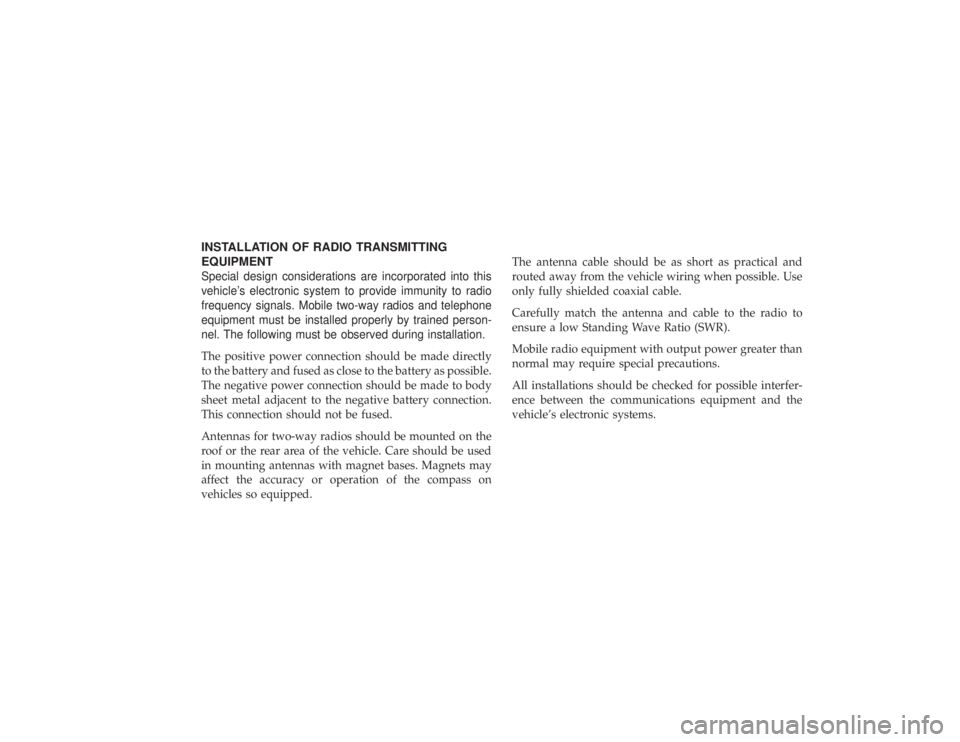Page 22 of 348
NOTE:The line of transmission must not be blocked
with metal objects.
To Unlock The Doors
Push and release the UNLOCK button on the RKE
transmitter to unlock the doors. The park lights and turn
signal lights will flash to acknowledge the signal and the
illuminated entry system will turn on.
NOTE:The Door Unlock Indicator will illuminate in the
instrument panel when one or both doors are unlocked.
To Lock The Doors
Push and release the LOCK button on the RKE transmit-
ter: locking of doors, switching off of internal roof light
and single flashing of direction indicators.
If one or more door are open, the doors will not be
locked. This is indicated by a rapid flashing of the
direction indicators. The doors will be locked if the
decklid is open however.
When a speed of more than 12 mph (20 km/h) is reached,
the doors will be locked automatically if the Autoclose
Key Fob
1 — Vehicle Key
2 — Push To Open/Close Vehicle Key 20 THINGS TO KNOW BEFORE STARTING YOUR VEHICLE
Page 250 of 348
▫Appearance Care And Protection From
Corrosion...........................280
�FUSES..............................287
▫Engine Compartment Fuses..............288
▫Dashboard Fuse Box...................290
�VEHICLE STORAGE....................292
�REPLACEMENT BULBS.................292
�BULB REPLACEMENT..................294
▫Front Light Clusters...................294
▫Front Side Marker.....................299
▫Rear Light Clusters....................300
▫Direction Indicators...................300▫Tail Lights/Brake Lights................301
▫Reversing Light......................301
▫Third Brake Lights....................302
▫License Plate Lights...................303
▫Roof Light..........................304
▫Luggage Compartment Roof Light.........305
�FLUID CAPACITIES....................306
�
FLUIDS, LUBRICANTS AND GENUINE PARTS . .307
▫Engine.............................307
▫Chassis............................309
248 MAINTAINING YOUR VEHICLE
Page 306 of 348
Roof Light
To change the bulb, proceed as follows:
1. Remove roof light working at the points indicated by
the arrows.2. Open protective flap (2) and replace bulb (1), releasing
it from the side contacts. Make sure that the new bulb
is correctly secured between the contacts.
Roof Light
1 — Bulb
2 — Protective Flap 304 MAINTAINING YOUR VEHICLE
Page 307 of 348
3. Close protective flap (2) and install roof light in its
housing, making sure that it is locked in place.
Luggage Compartment Roof Light
To replace the bulb, proceed as follows:
1. Open the luggage compartment and remove luggage
compartment roof light, working in the direction
shown by the arrow.
2. Open light protector (2) and replace the bulb.
3. Close protector on the lens.
1 — Light Cover
2 — Light Protector
7
MAINTAINING YOUR VEHICLE 305
Page 308 of 348
4. Install luggage compartment roof light by inserting it
in its correct position, first on one side and then
pressing on the other side until it clicks into place.
FLUID CAPACITIES
U.S. Metric
Fuel (Approximate)
1.750 Turbo Engine 10.5 Gallons 40 Liters
Reserve Fuel 1.1 Gallons 4 Liters
Engine Oil with Filter
1.750 Turbo Engine 6.1 Quarts 5.8 Liters
Cooling System
1.750 Turbo Engine (MOPAR®
Antifreeze/Engine Coolant 10
Year/150,000 Mile Formula).11.2 Quarts 10.6 Liters
306 MAINTAINING YOUR VEHICLE
Page 347 of 348

INSTALLATION OF RADIO TRANSMITTING
EQUIPMENTSpecial design considerations are incorporated into this
vehicle’s electronic system to provide immunity to radio
frequency signals. Mobile two-way radios and telephone
equipment must be installed properly by trained person-
nel. The following must be observed during installation.
The positive power connection should be made directly
to the battery and fused as close to the battery as possible.
The negative power connection should be made to body
sheet metal adjacent to the negative battery connection.
This connection should not be fused.
Antennas for two-way radios should be mounted on the
roof or the rear area of the vehicle. Care should be used
in mounting antennas with magnet bases. Magnets may
affect the accuracy or operation of the compass on
vehicles so equipped.The antenna cable should be as short as practical and
routed away from the vehicle wiring when possible. Use
only fully shielded coaxial cable.
Carefully match the antenna and cable to the radio to
ensure a low Standing Wave Ratio (SWR).
Mobile radio equipment with output power greater than
normal may require special precautions.
All installations should be checked for possible interfer-
ence between the communications equipment and the
vehicle’s electronic systems.